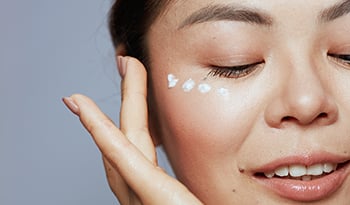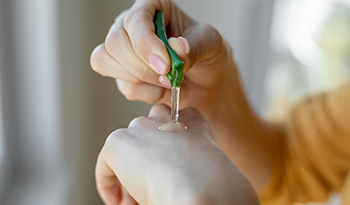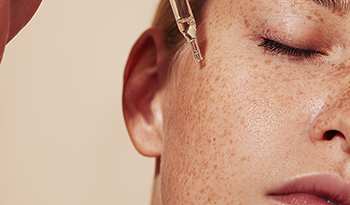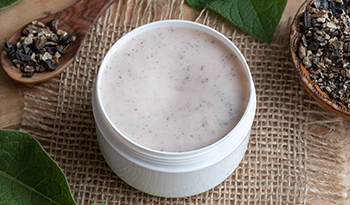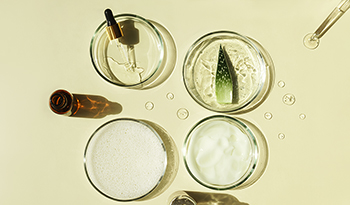5 Important Vitamins to Incorporate Into Your Skincare Routine
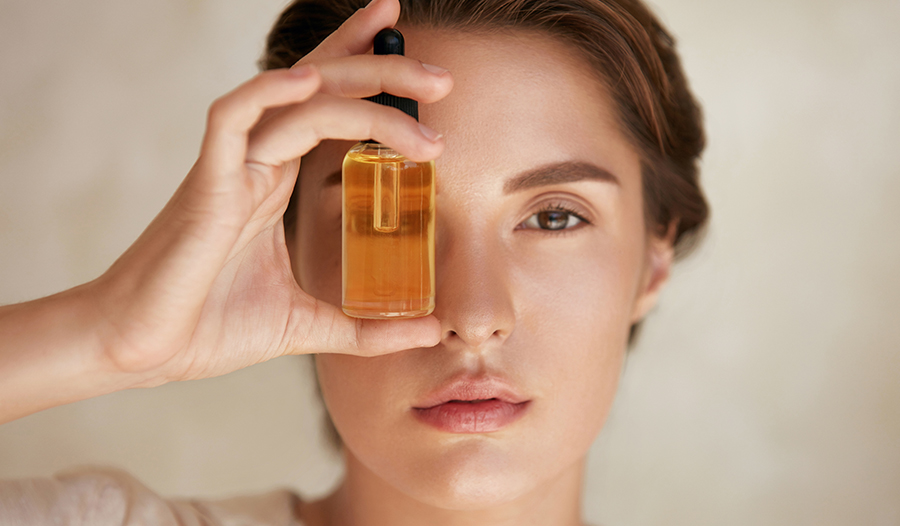
Vitamins aren't just for taking internally; you can apply them topically to the skin as well. There are a number of vitamins that have well-recognized effects on the skin, and incorporating these into a standard skincare routine can help you reach your skincare goals. In this post, I’ll go over the research and dermatologist-approved uses for vitamins on the skin, including vitamins A, B, C, E, and K.
Before we dive in, there are a few things to consider. The ideal way to incorporate vitamins into a skincare routine is to first make sure you have the basics down before adding in more products. When I’m counseling people about skincare, I usually tell people that you can’t add in all the extras and fun stuff until you make sure you’re doing the fundamentals correctly first.
The building blocks of a good skincare routine are 1) a good gentle cleanser, 2) daily application of sunscreen, and 3) a lightweight moisturizer. If you are doing these already, you are ahead of the game. From there, the products you choose depend on what your skincare goals are. For some, the goal might be acne prevention and treatment. For others, it may be treating hyperpigmentation, and for others, it may be anti-aging. Maybe it’s even all of these things! Here’s how different vitamins can affect the skin.
Vitamin A
Alternate names/forms: retinol, retinaldehyde, retinoic acid, adapalene, tretinoin, tazarotene, retinyl propionate
Uses: acne, anti-aging, hyperpigmentation
Details: Vitamin A is one of the most important vitamins in dermatology. Vitamin A is a fat-soluble vitamin that can be found in dairy products, fish, liver, and red/orange fruits and vegetables such as carrots, cantaloupe, and tomatoes. The family of vitamin A derivatives that show up in skincare products is referred to as retinoids. I bet if you polled a large group of dermatologists, you would find that the vast majority use some vitamin A formulation regularly on their skin. In oral forms, dermatologists use retinoids to treat severe acne, skin lymphoma, psoriasis, and other conditions. Topically, retinoids are used for acne, wrinkling, discoloration, and roughness. Retinoids work by regulating skin cell turnover, boosting collagen production, and inhibiting pigment production and transfer to skin cells. Vitamin A derivatives are chock-full of potential benefits for the skin.
There are a few things to know about retinoids if you’re going to use them. First, some of the vitamin A derivatives break down when exposed to sunlight, so it’s recommended to use retinoids at night. The strongest retinoids are available by prescription only, so if you’re using an over-the-counter product and you want to step it up a notch, consult a board-certified dermatologist. Cosmetic retinol products such as those containing retinaldehyde, retinol, or retinyl propionate on the ingredient labels can be bought without a prescription. These are less strong, and they also generally have fewer side effects.
Adverse effects: Dryness, redness, peeling, stinging. These effects are expected to happen when using a retinoid. The good news is that regular use of sunscreen and moisturizers can help minimize these effects, and the skin does get accustomed to the retinoids after using them for a while. One way to help prevent these side effects is to decrease the frequency of how often the retinoid is used. For example, some people may only be able to tolerate using a retinoid every other day, or even just a couple of times a week. For anyone considering using a topical retinoid, it is important to know that it should not be used during pregnancy or breastfeeding.
Vitamin B
Alternate names/forms: niacinamide, nicotinamide, nicotinic acid, niacin, vitamin B3, vitamin B5, panthenol
Uses: Acne, anti-inflammatory, skin barrier function, wound-healing, skin tone
Details: Vitamin B vitamins are a group of eight water-soluble vitamins that are all a little bit different, but frequently coexist. For the purposes of this article, we’ll focus on vitamin B3 (niacinamide), which has the most reported effects on the skin, although vitamin B5 (panthenol) also has benefits in skin hydration and barrier protection. Niacinamide has been shown to improve skin barrier function, which helps prevent redness, irritation, and water loss from the skin. Niacinamide has also been shown to inhibit pigment production, which helps reduce the appearance of hyperpigmentation. It can improve skin tone and texture by altering sugar proteins in the skin, and may even reduce skin wrinkles.
Adverse effects: Minimal side effects have been reported with niacinamide on the skin—it is generally well tolerated.
Vitamin C
Alternate names/forms: ascorbic acid, magnesium ascorbyl phosphate, ascorbyl palmitate, ascorbyl phosphate
Uses: Antioxidant, anti-aging, brightening, photoprotection
Details: Because vitamin C is an antioxidant, it works by combating damage and breakdown of the skin’s cellular DNA, collagen, and elastin. This damage happens over time due to the skin being exposed to environmental stressors in life such as the sun, smoking, and pollution. Vitamin C is also a key factor in how collagen is made and stabilized in the skin. Because it performs all these functions in the skin, it is thought that topically applied vitamin C products can help prevent some of the skin changes that occur as we age, like wrinkles and loose skin. Vitamin C also interferes with one of the enzymes (tyrosinase) that is responsible for making melanin (pigment), so topical vitamin C is often touted as a skin brightener to help minimize brown spots, discoloration, and undereye circles. The tough thing about vitamin C is that it is highly unstable, so even though it has demonstrated effects in the lab, in most skincare products, it probably breaks down when it is exposed to oxygen and light. Vitamin C and vitamin E in combination are thought to help stabilize each other and therefore maximize the chances of it being effective. In addition, vitamin C, in combination with vitamin E and ferulic acid, may increase the effectiveness up to eightfold. The other thing to consider is that for vitamin C to make a difference in collagen, it has to penetrate through the outer layer of skin into the dermis, which can be difficult to formulate.
Adverse effects: Vitamin C may cause a yellowish discoloration of the skin or irritation.
Vitamin E
Alternate names/forms: tocopherol acetate, alpha-tocopherol
Uses: Antioxidant, anti-aging, moisturizing, scar treatment
Details: Vitamin E is one of the fat-soluble vitamins and can be found in nuts, oils, fish, avocado, and greens. Vitamin E is an antioxidant, which means that it “scavenges free radicals” that are responsible for creating stress, inflammation, and damage in the body. Due to its touted antioxidant and wound-healing properties, Vitamin E shows up in a lot of cosmetic products, as well as scar and burn creams. Even though it’s well accepted that Vitamin E has antioxidant properties, it’s hard to know how much it is actually working when it is applied to the skin, because it can break down when exposed to light and oxygen. Vitamin E is often combined with vitamin C in skincare products because the two ingredients combined are thought to work together to be more effective. Regardless of its antioxidant properties, I definitely like Vitamin E as a moisturizer. The other interesting thing to know about vitamin E is that despite popular belief that vitamin E helps minimize scarring and promote wound healing, scientific studies have failed to demonstrate any significant improvements with vitamin E for these purposes.
Adverse effects: Vitamin E belongs to a family called “tocopherols,” which is well-known for causing both allergic and irritant contact dermatitis. The good news is that most cosmetic-grade formulations of vitamin E rarely cause allergies. Most of the reactions reported on the skin were due to people breaking open oral vitamin E capsules and putting them on their skin, which was not the intended use.
Vitamin K
Alternate names/forms: phytonadione, phytomenadione
Uses: bruising, dark undereye circles
Details: Vitamin K is one of the fat-soluble vitamins. In nature, it is found primarily in leafy green vegetables. Vitamin K is an essential vitamin that our body uses to help form clots in order to stop bleeding. In fact, doctors use IV formulations of vitamin K to help reverse severe bleeding, especially in people who are taking certain blood thinner medications. Because vitamin K helps prevent bleeding, some dermatologists recommend topical vitamin K products after cosmetic or surgical procedures to help minimize bruising. This is supported by some small studies and refuted in others. One high-quality (double-blind randomized placebo-controlled) study of 22 patients showed that pretreatment with vitamin K before laser treatment did not prevent bruising afterward, but Vitamin K application for two weeks after the laser treatment did reduce the severity of bruising. Other studies suggest that topical vitamin K may help minimize bruising on the arms and hands in older patients who have bruising caused by chronic sun damage (actinic purpura). Vitamin K often shows up in products targeting undereye circles. Darkness under the eyes can be caused by a lot of different reasons, such as shadows cast under the eyes due to a person’s facial anatomy, visibility or leakage from the underlying blood vessels, or pigment. Therefore, in people who have undereye circles due to issues with the blood vessels, topical vitamin K could be helpful, although there is not a lot of evidence to support this in the scientific literature.
Adverse effects: There is a low risk of developing contact dermatitis to vitamin K. However, vitamin K is often combined with other ingredients, which may cause skin irritation. This is especially important to consider if the product is being used on the delicate, thin skin under the eyes. It’s always a good idea to do a “patch test” on the inside of the arm for a few weeks first to make sure your skin won’t be bothered.
Takeaway
As you can see, there are many ways in which vitamins can be incorporated into a healthy skincare routine to achieve healthy, glowing skin. The key is to find the right products without overdoing it. The most common mistake people make is to use tons of products on their faces because they’re trying to use ALL of the vitamins and ingredients. I like to focus on trying one or two ingredients and stick with them consistently for a while before considering adding or changing products.
إخلاء مسؤولية:لا يهدف هذا المركز الصحي إلى تقديم التشخيص...












































































 جدول المحتويات
جدول المحتويات



